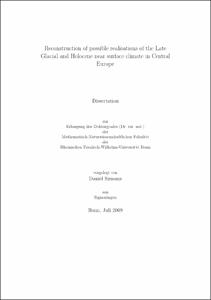Simonis, Daniel: Reconstruction of possible realisations of the Late Glacial and Holocene near surface climate in Central Europe. - Bonn, 2010. - Dissertation, Rheinische Friedrich-Wilhelms-Universität Bonn.
Online-Ausgabe in bonndoc: https://nbn-resolving.org/urn:nbn:de:hbz:5N-21111
Online-Ausgabe in bonndoc: https://nbn-resolving.org/urn:nbn:de:hbz:5N-21111
@phdthesis{handle:20.500.11811/4567,
urn: https://nbn-resolving.org/urn:nbn:de:hbz:5N-21111,
author = {{Daniel Simonis}},
title = {Reconstruction of possible realisations of the Late Glacial and Holocene near surface climate in Central Europe},
school = {Rheinische Friedrich-Wilhelms-Universität Bonn},
year = 2010,
month = may,
note = {This thesis presents several aspects of reconstructing physical consistent realisations of past climatological fields. Local climate reconstructions are obtained by a method, which is based on the idea of indicator taxa and uses presence of taxa as proxy variable. In previous studies, the indicator taxa approach has been enhanced to a probabilistic Bayesian reconstruction method, which provides conditional probability density functions as reconstruction result.
Up to now bivariate normal distributions or mixture models have been applied for reconstructing January and July temperatures. A three dimensional copula approach exists for the incorporation of annual precipitation. Now mixture models are embedded into this approach and a new set of three dimensional transfer functions is estimated. The differences to two dimensional mixture models are examined.
The local climate reconstruction results are interpolated in a dynamically consistent way by applying a variational analysis with weak physical constraint. For reconstructing fields of annual precipitation, a different physical constraint is implemented into the analysis.
A new point of view for the interpretation of climate reconstruction results is proposed. It emphasizes, that the analysis result has to be seen as conditional expectation of the desired climatological field. This expectation is only the mean of all possible realisations of the past climate. In this work, possible realisations are presented and it becomes clear, that these can differ considerably from the mean field. The realisations are obtained by resampling from the analysis error covariance matrix of the variational analysis.
Reconstructions of near surface January and July temperature anomalies for two Late Glacial (13000 and 12000 cal. BP) and two Holocene (8000 and 6000 cal. BP) time slices are provided, based on pollen and macrofossil data from 85 different locations in Europe. The variational analysis is for the first time applied for reconstructing a cold climate state. It becomes clear that the sensitivity of the botanical proxies, which are used in this work, is too low for capturing the difference between 13000 and 12000 BP. Both time slices are reconstructed significantly colder than the Holocene. The results for the Holocene time slices agree well with results from other studies. No significant differences to the modern 1961-90 climate can be found.
A successful reconstruction of fields of annual precipitation anomalies is not possible. Apparently the botanical proxies, applied in this work, are not sensitive enough for this purpose. Both, the results for the Late Glacial and the results for annual precipitation call for the incorporation of other proxy data and a multiproxy approach.},
url = {https://hdl.handle.net/20.500.11811/4567}
}
urn: https://nbn-resolving.org/urn:nbn:de:hbz:5N-21111,
author = {{Daniel Simonis}},
title = {Reconstruction of possible realisations of the Late Glacial and Holocene near surface climate in Central Europe},
school = {Rheinische Friedrich-Wilhelms-Universität Bonn},
year = 2010,
month = may,
note = {This thesis presents several aspects of reconstructing physical consistent realisations of past climatological fields. Local climate reconstructions are obtained by a method, which is based on the idea of indicator taxa and uses presence of taxa as proxy variable. In previous studies, the indicator taxa approach has been enhanced to a probabilistic Bayesian reconstruction method, which provides conditional probability density functions as reconstruction result.
Up to now bivariate normal distributions or mixture models have been applied for reconstructing January and July temperatures. A three dimensional copula approach exists for the incorporation of annual precipitation. Now mixture models are embedded into this approach and a new set of three dimensional transfer functions is estimated. The differences to two dimensional mixture models are examined.
The local climate reconstruction results are interpolated in a dynamically consistent way by applying a variational analysis with weak physical constraint. For reconstructing fields of annual precipitation, a different physical constraint is implemented into the analysis.
A new point of view for the interpretation of climate reconstruction results is proposed. It emphasizes, that the analysis result has to be seen as conditional expectation of the desired climatological field. This expectation is only the mean of all possible realisations of the past climate. In this work, possible realisations are presented and it becomes clear, that these can differ considerably from the mean field. The realisations are obtained by resampling from the analysis error covariance matrix of the variational analysis.
Reconstructions of near surface January and July temperature anomalies for two Late Glacial (13000 and 12000 cal. BP) and two Holocene (8000 and 6000 cal. BP) time slices are provided, based on pollen and macrofossil data from 85 different locations in Europe. The variational analysis is for the first time applied for reconstructing a cold climate state. It becomes clear that the sensitivity of the botanical proxies, which are used in this work, is too low for capturing the difference between 13000 and 12000 BP. Both time slices are reconstructed significantly colder than the Holocene. The results for the Holocene time slices agree well with results from other studies. No significant differences to the modern 1961-90 climate can be found.
A successful reconstruction of fields of annual precipitation anomalies is not possible. Apparently the botanical proxies, applied in this work, are not sensitive enough for this purpose. Both, the results for the Late Glacial and the results for annual precipitation call for the incorporation of other proxy data and a multiproxy approach.},
url = {https://hdl.handle.net/20.500.11811/4567}
}






